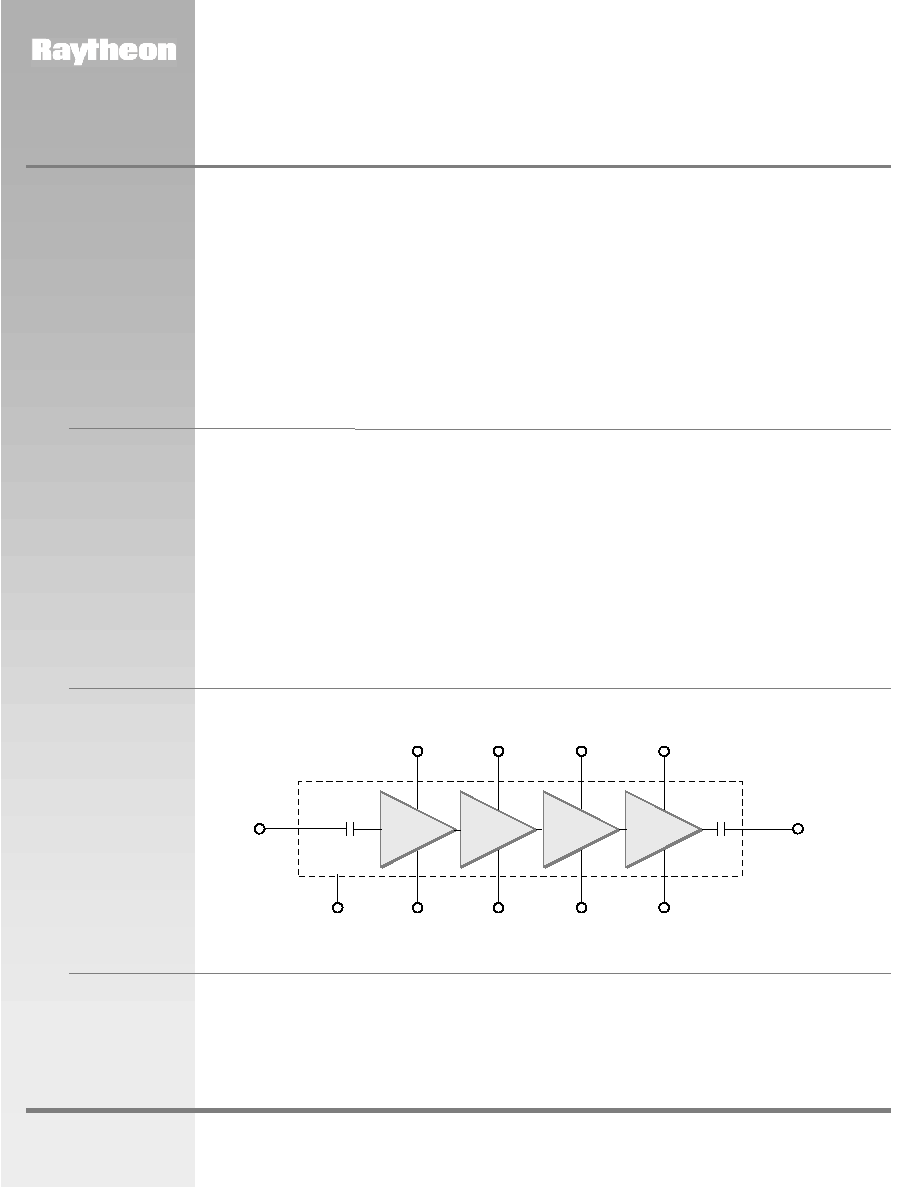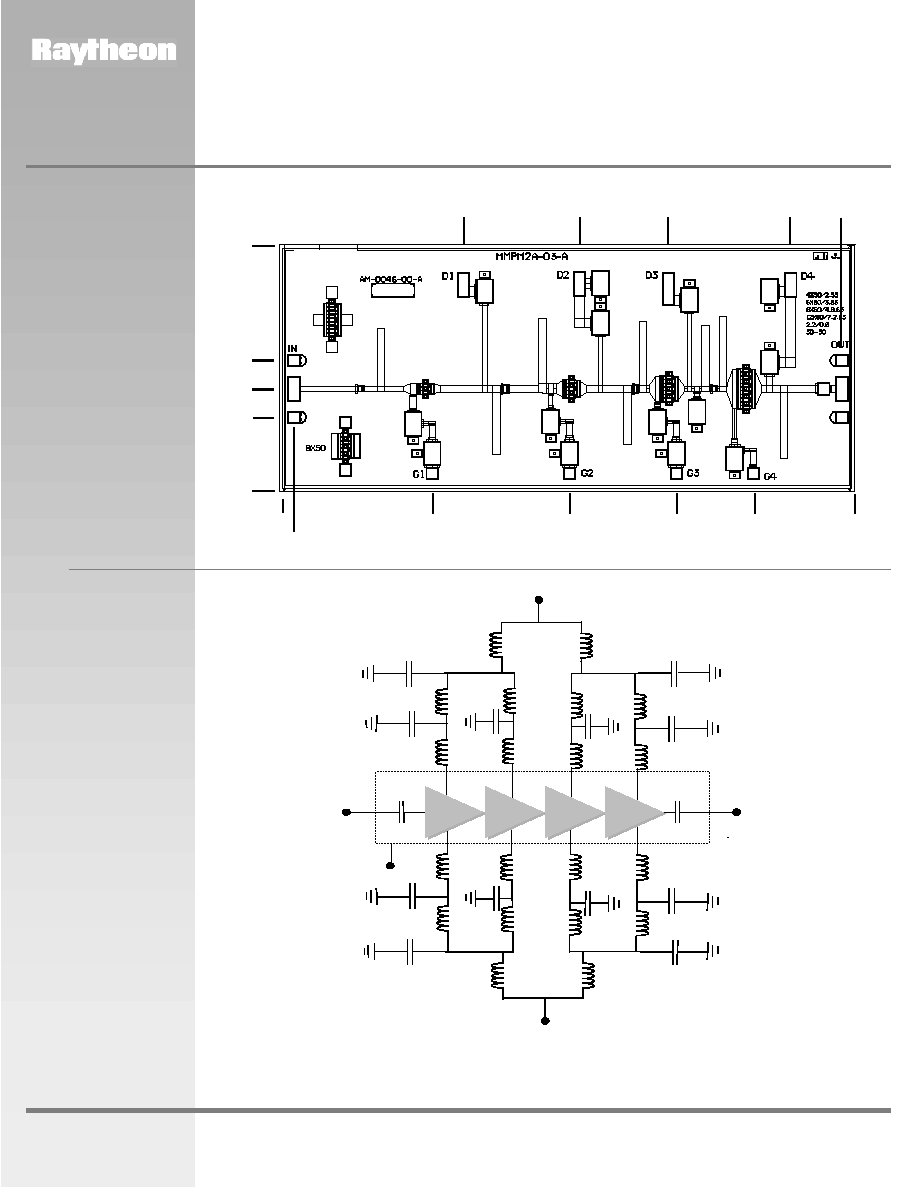
Raytheon RF Components
362 Lowell Street
Andover, MA 01810
Revised January 15, 2001
Page 1
www.raytheon.com/micro
Characteristic performance data and specifications are subject to change without notice.
PRODUCT INFORMATION
Description
4 mil substrate
Small-signal gain 22 dB (typ.)
Pout 1 dB comp 23 dBm (typ.)
Chip size 4.67 mm x 2.00 mm
Features
The RMDA1840 is a 4-stage GaAs MMIC amplifier designed as a 18 to 40 GHz broad band amplifier for use in point
to point radios, point to multi-point communications, LMDS, and other millimeter wave applications. The
RMDA1840 utilizes Raytheon's 0.25µm power PHEMT process and is sufficiently versatile to serve in a variety of
applications, such as a driver amplifier or a frequency multiplier.
RMDA1840
18-40 GHz Broad Band Driver Amplifier
MMIC
Electrical
Characteristics
(At 25°C),
50
system,
Vd = +5 V,
Quiescent
Current
Idq = 400 mA
Parameter
Min
Typ
Max Unit
Frequency Range
18
40
GHz
Gate Supply Voltage (Vg)
1
-0.2
V
Gain Small Signal at
Pin = -5 dBm
20
22
dB
Gain Variation vs
Frequency
+/-2.5
dB
Gain at 1dB Compression
21
dB
Power Output at 1 dB
Compression
23
dBm
Parameter
Min
Typ
Max Unit
Power Output Saturated:
Pin = +3 dBm
21
24
dBm
Power Added Efficiency
(PAE): at P1dB
15
%
Input Return Loss
(Pin = -5 dBm)
8
dB
Output Return Loss
(Pin = -5 dBm)
10
dB
Notes:
1.
Typical range of gate voltage is -1.0 to 0 V to set Idq of 400 mA.
Absolute
Maximum
Ratings
Parameter
Symbol
Value
Units
Positive DC voltage (+5 V Typical)
Vd
+6
Volts
Negative DC voltage
Vg
-2
Volts
Simultaneous (Vd - Vg)
Vdg
+8
Volts
Positive DC Current
I
D
442
mA
RF Input Power (from 50
source)
P
IN
+15
dBm
Operating Baseplate Temperature
T
C
-30 to +85
°C
Storage Temperature Range
T
stg
-55 to +125
°C
Thermal Resistance
R
JC
53
°C/W
(Channel to Backside)

Raytheon RF Components
362 Lowell Street
Andover, MA 01810
Revised January 15, 2001
Page 2
www.raytheon.com/micro
Characteristic performance data and specifications are subject to change without notice.
PRODUCT INFORMATION
Figure 1
Functional Block
Diagram
RF IN
RF OUT
Drain Supply
Vd1
Drain Supply
Vd2
Drain Supply
Vd3
Drain Supply
Vd4
Gate Supply
Vg1
Gate Supply
Vg2
Gate Supply
Vg3
Gate Supply
Vg4
Ground
Back of Chip
MMIC Chip
CAUTION: THIS IS AN ESD SENSITIVE DEVICE.
CAUTION: LOSS OF GATE VOLTAGES (Vg) WHILE DRAIN VOLTAGES (Vd) IS PRESENT MAY DAMAGE THE
AMPLIFIER CHIP.
The following sequence of steps must be followed to properly test the amplifier.
Step 1: Turn off RF input power.
Step 2: Connect the DC supply grounds to the grounds
of the chip carrier. Slowly apply negative gate
bias supply voltage of -1.5 V to Vg.
Step 3: Slowly apply positive drain bias supply voltage
of +5 V to Vd.
Step 4: Adjust gate bias voltage to set the quiescent
current of Idq = 400 mA.
Step 5: After the bias condition is established, RF input
signal may now be applied at the appropriate
frequency band.
Step 6: Follow turn-off sequence of:
(i) Turn off RF input power,
(ii) Turn down and off drain voltage (Vd),
(iii) Turn down and off gate bias voltage (Vg).
Recommended
Procedure
for Biasing and
Operation
CAUTION: THIS IS AN ESD SENSITIVE DEVICE.
Chip carrier material should be selected to have GaAs compatible thermal coefficient of expansion and high thermal
conductivity such as copper molybdenum or copper tungsten. The chip carrier should be machined, finished flat,
plated with gold over nickel and should be capable of withstanding 325°C for 15 minutes.
Die attachment should utilize Gold/Tin (80/20) eutectic alloy solder and should avoid hydrogen environment for
PHEMT devices. Note that the backside of the chip is gold plated and is used as RF ground.
These GaAs devices should be handled with care and stored in dry nitrogen environment to prevent contamination
of bonding surfaces. These are ESD sensitive devices and should be handled with appropriate precaution including
the use of wrist grounding straps. All die attach and wire/ribbon bond equipment must be well grounded to prevent
static discharges through the device.
Recommended wire bonding uses 3 mils wide and 0.5 mil thick gold ribbon with lengths as short as practical
allowing for appropriate stress relief. The RF input and output bonds should be typically 0.012" long corresponding
to a typically 2 mil between the chip and the substrate material.
Application
Information
RMDA1840
18-40 GHz Broad Band Driver Amplifier
MMIC

Raytheon RF Components
362 Lowell Street
Andover, MA 01810
Revised January 15, 2001
Page 3
www.raytheon.com/micro
Characteristic performance data and specifications are subject to change without notice.
PRODUCT INFORMATION
Figure 2
Chip Layout and Bond
Pad Locations
Chip Size is 4.67 mm x
2.0 mm x 100
µ
m. Back
of chip is RF and DC
ground
Dimensions in mm
0.0
4.67
1.50
1.23
0.11
2.35
3.22
3.84
2.44
3.16
4.15
4.57
0.0
2.00
1.06
0.83
0.60
Figure 3
Recommended
Application Schematic
Circuit Diagram
Note: For output power level detection, bias both detector and reference diodes. DC voltage difference between detector and reference can be used
to measure output power after calibration. If output power level detection is not desired, do not make connection to detector bond pad.
L
Drain Supply
Vd = +5 V
100pF
100pF
10,000pF
L
L
L
100pF
100pF
10,000pF
L
L
L
L
L
L
L = Bond Wire Inductance
Ground
(Back of Chip)
MMIC Chip
RF OUT
RF IN
100pF
10,000pF
Gate Supply
Vg
10,000pF
L
L
L
L
L
L
L
L
100pF
100pF
100pF
L
L
RMDA1840
18-40 GHz Broad Band Driver Amplifier
MMIC

Raytheon RF Components
362 Lowell Street
Andover, MA 01810
Revised January 15, 2001
Page 4
www.raytheon.com/micro
Characteristic performance data and specifications are subject to change without notice.
PRODUCT INFORMATION
Figure 4
Recommended
Assembly Diagram
RF
Input
RF
Output
5mil Thick
Alumina
50-Ohm
5 mil
Thick
Alumina
50-Ohm
L< 0.015"
(4 Places)
Die-Attach
80Au/20Sn
Vg (Negative)
10,000pF
Vd (Positive)
10,000pF
100pF
100pF
100pF
100pF
10,000pF
10,000pF
2 mil Gap
100pF
100pF
100pF
100pF
Note Use 0.003" by 0.0005" Gold Ribbon for bonding. RF input and output bonds should be less than 0.015" long with stress relief. If output
power level detection is not desired, do not make connection to detector bond pad.
RMDA1840
18-40 GHz Broad Band Driver Amplifier
MMIC




